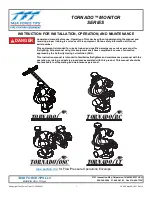
Intelect® Shortwave 400
SAFETy iNSTruCTiONS
7
•
Shortwave diathermy should not be used on patients who
have any implanted metallic lead or any implanted system
that may contain a lead. Both the heating and non-heating
modes of operation pose a risk of tissue destruction. If
you are a licensed practitioner who implants or monitors
patients with leads or implanted systems with leads,
explain to the patient what diathermy is and stress that
they should not receive shortwave diathermy treatment.
If you are a licensed practitioner who uses diathermy
in your practice, be sure to ask patients about possible
implants before deciding to administer shortwave
diathermy therapy.
•
Do not administer shortwave diathermy therapy to a
patient who has had an implant in the past unless you
are absolutely certain that the implant and all leads in
their entirety have been removed. Note that the leads
are often left implanted after the implant is removed.
•
This unit generates non-ionizing radiation. Patients with
implanted electronic devices, such as cardiac pacemakers
and defibrillators, cochlear implants, bone growth
stimulators, deep brain stimulators, spinal cord stimulators,
and other nerve stimulators, must not be treated, even if
the device has been turned off.
•
The function of certain implanted devices (e.g.,
pacemakers) may be adversely affected during treatment
with shortwave diathermy. In case of doubt, the advice of
a licensed practitioner in charge of the patient should be
sought.
•
Never, under any circumstances, attempt to hold any of the
electrodes in your hands during therapy.
•
The unit must be installed so that there is no danger to the
patient, the operator or other persons. Therefore, you must read
the safety instruction and contraindications.
•
In case of damage from transport that could endanger personal
safety, the unit must not be connected to the Mains Power
Supply.
•
Keep all unnecessary persons out of the treatment location. No
other person should be located within 2 meters of the unit.
DANGER
DANGER











































